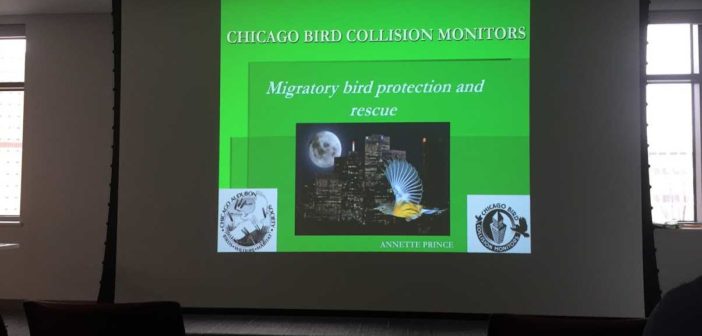The Center for Global Education hosted the second Sustaining the Globe event of the term on Feb. 7. The presentation was led by the Director of the Chicago Bird Collision Monitors, Annette Prince, and focused on migratory bird protection and rescue.
Since 2003, the Chicago Bird Collision Monitors (CBCM) has been working with over 200 volunteers to protect migratory birds through rescue, education and outreach. They advocate for bird-safe lighting and buildings to be designed in a way that bird collisions will be avoided.
Each year as birds are migrating south to warmer regions, they make their way across the middle of the U.S. through the Mississippi Flyway. Birds are considered nighttime migrants because they follow the stars and moon to travel, as Prince said, “stars are a bird’s Google Map.”
On the way through, they fly across Chicago. Because of the city’s massive buildings and bright lights, this concrete jungle is dangerous for birds to fly through. They confuse the building lights for stars and think they have reached a safe place to rest for the day.
Unfortunately, because of the light pollution, birds that are attracted to cities will fly down to nest for the day. As they head down, they confuse a window for an opening in a building. They run into the windows at full-force and will either die or be critically injured. Every year, an estimated one billion birds die from collisions.
The CBCM workers and volunteers walk the streets of Chicago every morning to look for birds that have fallen victim to urban hazards. Prince said of the thousands of birds found each year, 60 percent are dead while the other 40 percent are injured and transported to a wildlife rehabilitation center. Here, these birds heal within weeks and are released into the forest while birds that have died are sent to the Field Museum for research.
The Field Museum has seen evidence of a warming climate in these birds that have been brought to them from CBCM. Prince described the effect of climate change on the birds as evolution. As temperatures rise, their body size decreases as an adaptive response. Many of these birds are endangered species or at risk of becoming endangered due to climate disruption and light pollution.
Prince offered many solutions for what the city of Chicago has been doing that other buildings can learn from. As part of the “Lights Out Chicago!” movement, 90 to 100 percent of buildings in the city turn off their lights each day of the migrating season from 11 p.m. until sunrise since 2004. Cities and homes can also use products such as bird tape to make transparent or reflective windows visible to birds. Prince said the most important thing urban developers and architects can do to protect birds is to design their buildings smarter.
The CBCM is always looking for volunteers in both Chicago and the DuPage area. They also have a number to call if an injured bird is found: 777-988-1867.
The next Sustaining the Globe event will be Feb. 25 at Judy G. Stevenson (Ratio) Hall at 6 p.m. and will be presented by Ken Ilgunas titled “Trespassing Across America.”

